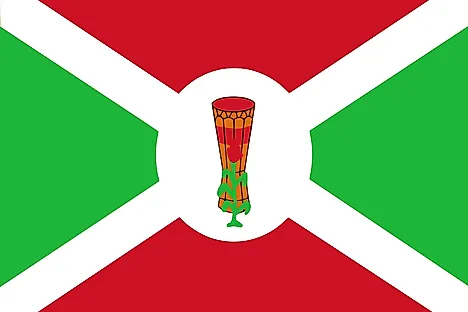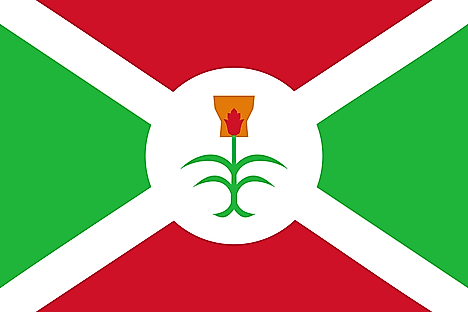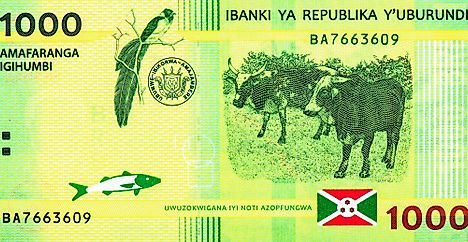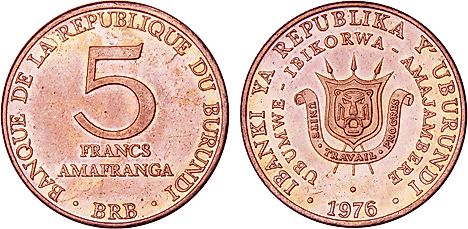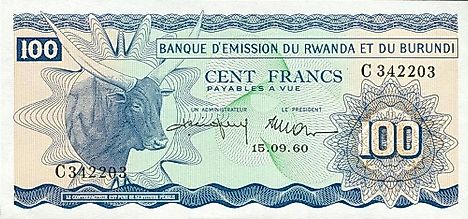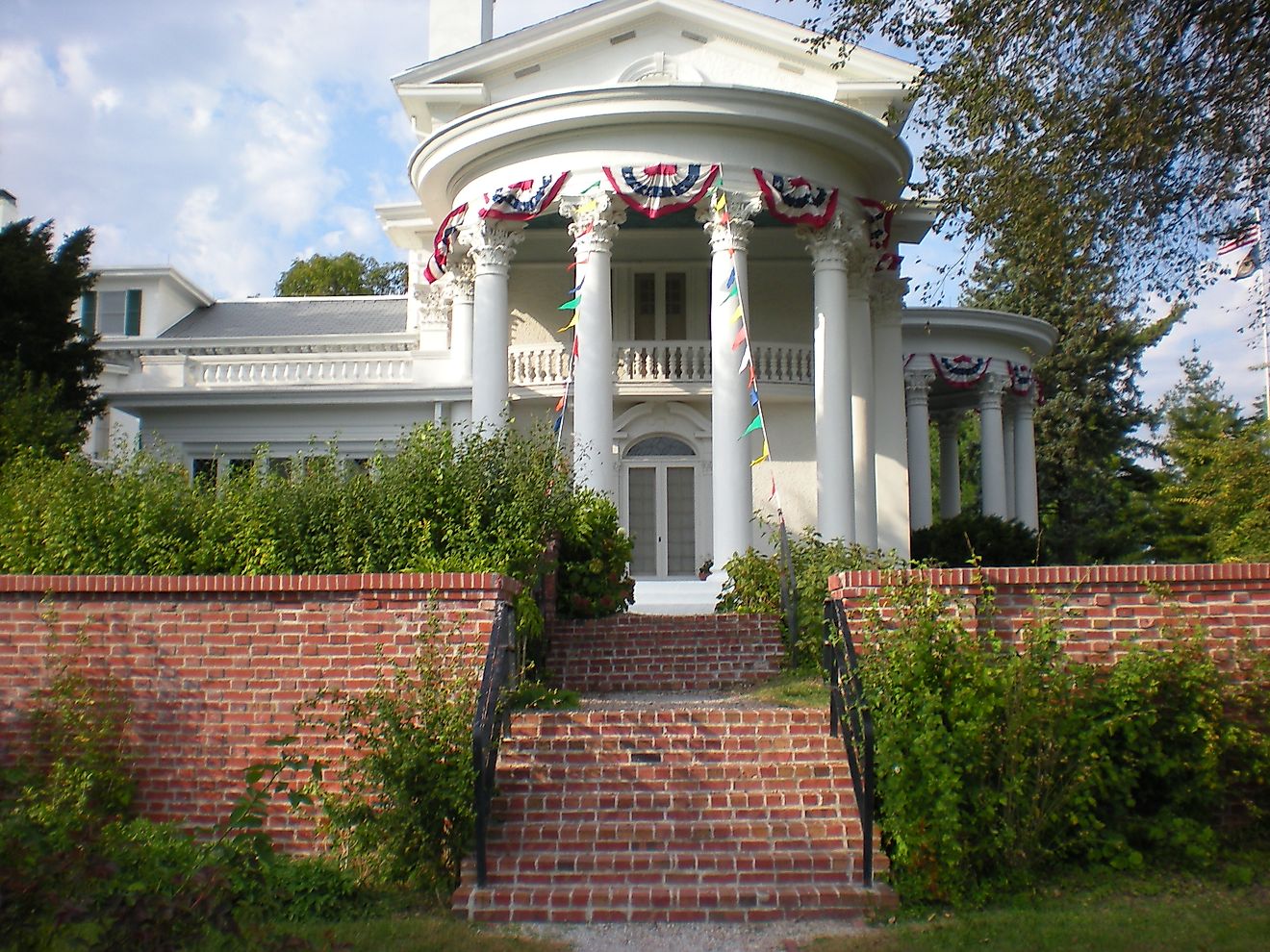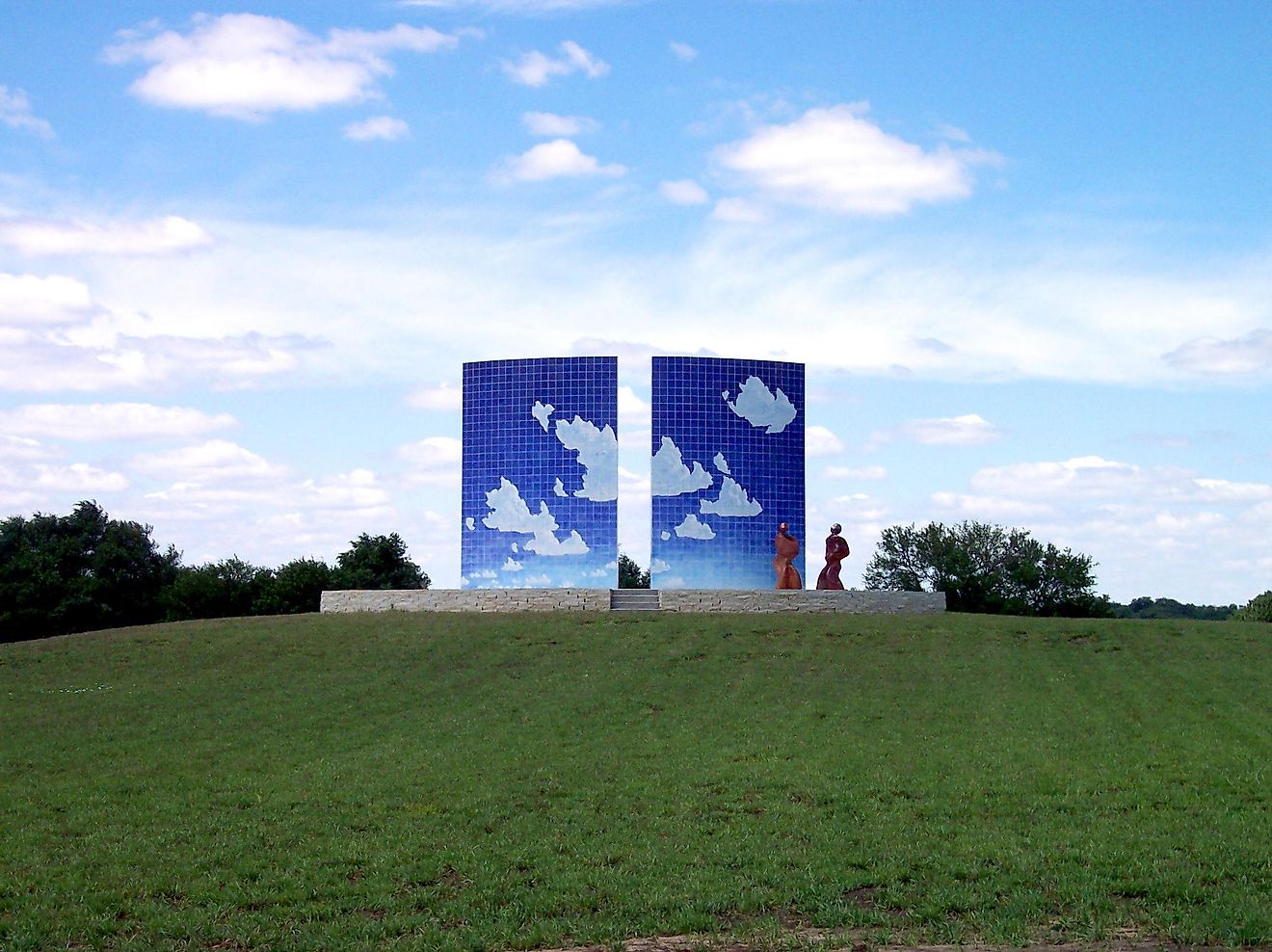Flags, Symbols & Currency of Burundi
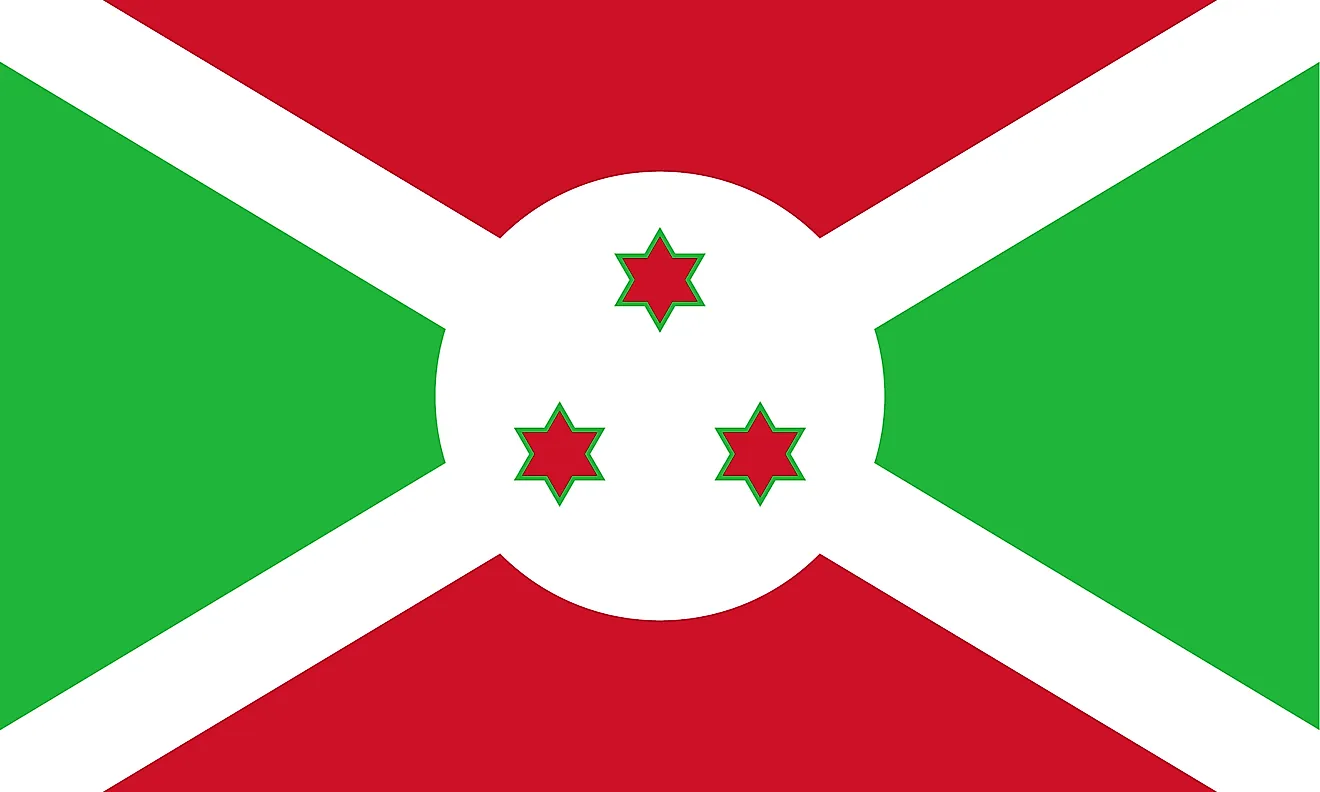
The current national flag of Burundi was officially adopted on June 28, 1967.
The flag features the red, green and white colors designed on a horizontal rectangle. It is divided by a white diagonal cross into two red triangles (top and bottom) and two green triangles (hoist side and fly side). At the flag’s center is a white disk superimposed at the saltire’s center bearing three red six-pointed stars outlined in green and arranged in a triangular design (one star above, two stars below). The red color represents the blood that was shed during Burundi’s struggle for independence that culminated in the country’s independence from Belgium in 1962, as well as the courage of the freedom fighters. The Green color symbolizes the hope and optimism the citizens have of the nation’s economic growth in the future, while white color represents purity and peace. The three green stars represents the elements of the national motto of Burundi - “Unité, Travail, Progrès.” (Unity, Work and Progress) The three stars on the flag’s center also symbolize the loyalty the citizens originally pledged to God, the country, and the king. It also represents the nation’s three main ethnic communities of the Hutu, Twa, and the Tusti. The original dimensions of the flag were 2:3 for the width and length respectively, but a Presidential decree of 1988 directed that this was changed to a width-length dimension of 3:5.
History of The Flag of Burundi
Burundi was a German colony in the late 19th century and the early 20th century. During this period the flag of the German East African Company was used. After the Great War, Burundi became a Belgian colony and as per the Treaty of Versailles, the German East African Company flag was replaced with that of the Belgian colony. The country gained independence in 1961 and immediately adopted a new flag whose design resembled that of the current flag but also had a “karyenda” drum supported by a sorghum plant. This traditional drum was a royal symbol and therefore represented the monarchy. This flag was in use until the monarchy was abolished in 1966.
Symbols of Burundi
The National Coat of Arms of Burundi
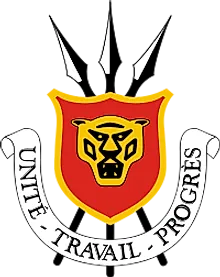
Burundi's coat of arms was adopted in 1966, and features a shield bearing the head of a lion. Three African spears rest behind the shield, and the national motto, "Unity, Work, Progress," is depicted in French below. The Kingdom of Burundi's national coat of arms inspired the design of the present one. Some of the differences included the former coat of arms having four spears instead of three and a royal drum called karyenda at the top surrounded by two laurels. The national motto was also different - Ganza Sabwa which means "(the mwami) rules and reigns."
National Motto
"Ubumwe, Ibikorwa, Iterambere" ("Unite, Travail, Progres") ("Unity, Work, Progress")
National Anthem
- Anthem Title: "Burundi Bwacu" ("Our Burundi")
- Music Composer: Marc Barengayabo
- Lyricist: Jean-Baptiste Ntahokaja and a group of writers
- Date of Adoption:1962
"Burundi Bwacu"("Our Burundi") is the national anthem of Burundi. It was written by a group of writers led by Jean-Baptiste Ntahokaja, a Catholic priest and was composed by Marc Barengayabo. The anthem was adopted upon independence in 1962 and has Kirundi and French lyrics, the two official languages of the country.
"Burundi Bwacu" (Kirundi)
Burundi bwacu, Burundi buhire,
Shinga icumu mu mashinga,
Gaba intahe y'ubugabo ku bugingo.
Warapfunywe ntiwapfuye,
Warahabishijwe ntiwahababuka.
Uhagurukana, Uhagurukana, Uhagurukana ubugabo burikukira.
Komerwa amashi n'amakungu, uhabwe impundu n'abawe,
Isamirane mu mashinga, Isamirane mu mashinga.
Burundi bwacu, ragi rya basokuru,
Ramutswa intahe n'ibihugu,
Ufatanije ishaka n'ubuhizi;
Vuza impundu wiganzuye uwakuganza uwakuganza.
Burundi bwacu, nkora mutima kuri twese,
Tugutuye amaboko, umutima n'ubuzima,
Imana yakuduhaye ikudutungire.
Horana ubumwe n'abagabo n'itekane.
Sagwa n'urweze, sagwa n'amahoro meza.
"Our Burundi"
Our Burundi, gentle country,
Take your place in the concert of nations,
Acceding to independence with honourable intentions.
Wounded and bruised, you have remained master of yourself.
When the hour came, you arose,
Lifting yourself proudly into the ranks of free peoples.
Receive, then, the congratulations of the nations
And the homage of your sons and daughters.
May your name ring out through the universe.
Our Burundi, sacred heritage from our forefathers,
Recognized as worthy of self-government,
With your courage you also have a sense of honour.
Sing the glory of liberty conquered again.
Our Burundi, worthy of our tenderest love,
We vow to your noble service our hands and hearts and lives.
May God, who gave you to us, keep you for us to venerate,
Under the shield of unity,
In peace, joy and prosperity.
The Currency of Burundi is the Burundian franc
The official currency of Burundi is the Burundian franc (FBu). The franc is nominally subdivided into 100 centimes. However, since Burundi started issuing its currency, the coins have never been issued in centimes. As a matter of fact, centime coins were only issued when the country was using Belgian Congo franc. Following discussions with leaders of the East African community, there were speculations that the East African Shilling would replace the Burundian franc by 2015.
Coins
The Bank of the Kingdom of Burundi rolled out 1-franc coins made of brass in 1965. However, in 1968 the brass coins were replaced by aluminum ones when the Bank of the Republic of Burundi, the central bank in the country, began issuing coins. The new coins comprised of cupro-nickel 10 francs together, with 1 and 5 aluminum franc coins. Both the 5- and 10-franc coins feature continuous milled edges. In 1976, a new set of 1- and 5-franc coins were once again introduced in the country and featured the coat of arms. Another set of new coins were introduced in Burundi, but this time they were 10 and 50 francs which were issued in 2011.
Banknotes
Between February 1964 and December 31, 1965, notes in denominations of 1,000, 500, 100, 50, 20, 10, and 5 were rolled out by the Issuing Bank of Rwanda and Burundi. The notes were printed with additional features including a diagonal hollow of the word 'BURUNDI' for use in the country. Between 1964 and 1965 there were irregular issues by the Bank of the Kingdom of Burundi (Banque du Royaume du Burundi) of the same denominations. The Bank of the Republic of Burundi started issuing notes for 20 francs and above in 1966, they were overprinted replacing the word 'Kingdom' with 'Republic.' The bank began issuing banknotes in denominations of 5,000, 1,000, 500, 100, 50, 20, and 10 francs. However, 10 francs were phased out by 1968, but they were soon replaced by franc coins. In 2001, the country was introduced to 2,000-franc banknotes, and in 2004, 10,000-franc notes were issued. An image of Burundian school kids taken by Kelly Fajack was used on the back of the 10,000-franc banknote.
Historical Currencies of Burundi
In 1916, following the occupation of Belgium in Germany, the franc became the official legal tender in Burundi. The Belgian Congo franc had replaced the German East African rupie as the legal tender in the country. This was used until the introduction of the Ruanda-Urundi franc in 1960. In 1964, the Burundian franc was introduced. By the end of 2015, there were plans to introduce a single currency in all the member countries of the East African Community; but as of November 2017, this plan has not yet materialized.
